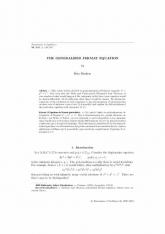
- Consulter un extrait
- Année : 2012
- Tome : 36
- Format : Électronique
- Langue de l'ouvrage :
Anglais - Class. Math. : 11D41; 11G30
- Pages : 119-149
Cet article étudie les généralisations de l'équation de Fermat $x^n + y^n = z^n$. Dès la démonstration du "grand théorème de Fermat" par Wiles et Taylor, on s'est démandé ce qu'il adviendrait si les exposants dans l'équation à trois termes étaient choisis différemment. Ou si l'on plaçait d'autres coefficients que $1$ devant les monômes. Nous discutons la réduction de la résolution de telles équations à la détermination des points rationnels d'un ensemble fini de courbes algébriques (définies sur $\mathbb{Q}$ si possible), puis résolvons complètement l'équation d'exposants $2, 3, 5$.
Théorème de Fermat, équation de Fermat généralisée, revêtement galoisien,
théorie des invariants

